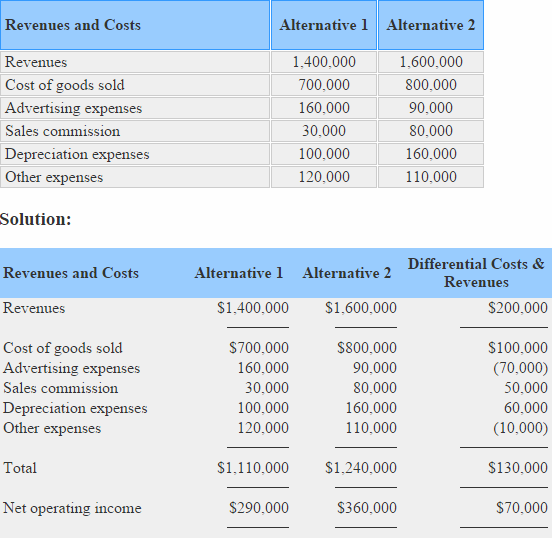Differential, opportunity and sunk costs
Costs may be classified as differential cost, opportunity cost and sunk cost. This classification is made for decision making purposes. Explanation and examples of differential, opportunity and sunk costs are given below:
Differential cost:
The work of managers includes comparison of costs and revenues of different alternatives. Differential cost (also known as incremental cost) is the difference in cost of two alternatives. For example, if the cost of alternative A is $10,000 per year and the cost of alternative B is $8,000 per year. The difference of $2,000 would be differential cost. The differential cost can be a fixed cost or variable cost.
Similarly the difference in revenue of two alternatives is known as differential revenue. For example, if alternative A’s revenue is $15,000 and alternative B’s revenue is $10,000. The difference of $5,000 would be differential revenue.
When different revenue generating alternatives are compared, the differential cost as well as differential revenues associated with each alternative is taken into account.
The terms “differential cost” and “differential revenue” used in managerial accounting are similar to the terms “marginal cost” and “marginal revenue” used in economics.
Example – computation of differential cost, differential revenues and differential net operating income:
The management of Galaxy company has two alternatives to choose from. Compute differential revenue, differential cost and differential net operating income from the information of two alternatives given below:

In the above example, total differential revenue is $200,000 (1,600,000 – 1,400,000), differential cost is $130,000 (1,240,000 – 1,110,000) and differential net operating income is $70,000 ($360,000 – $290,000).
If a decision is made on the basis of above computations, alternative 2 would be selected because it promises to generate more net operating income.
Opportunity cost:
Unlike other types of cost, opportunity cost does not require the payment of cash or its equivalent. It is a potential benefit or income that is given up as a result of selecting an alternative over another. For example, You have a job in a company that pays you $25,000 per year. For a better future, you want to get a Master’s degree but cannot continue your job while studying. If you decide to give up your job and return to school to earn a Master’s degree, you would not receive $25,000. Your opportunity cost would be $25,000.
Almost every alternative has an opportunity cost. It is not entered in the accounting records but must be considered while making decisions.
Sunk cost:
The costs that have already been incurred and cannot be changed by any decision are known as sunk costs. For example, a company purchased a machine several years ago. Due to change in fashion in several years, the products produced by the machine cannot be sold to customers. Therefore the machine is now useless or obsolete. The price originally paid to purchase the machine cannot be recovered by any action and is therefore a sunk cost.
Sunk costs should not be taken into account while making any decision because no action can revers them.

Leave a comment